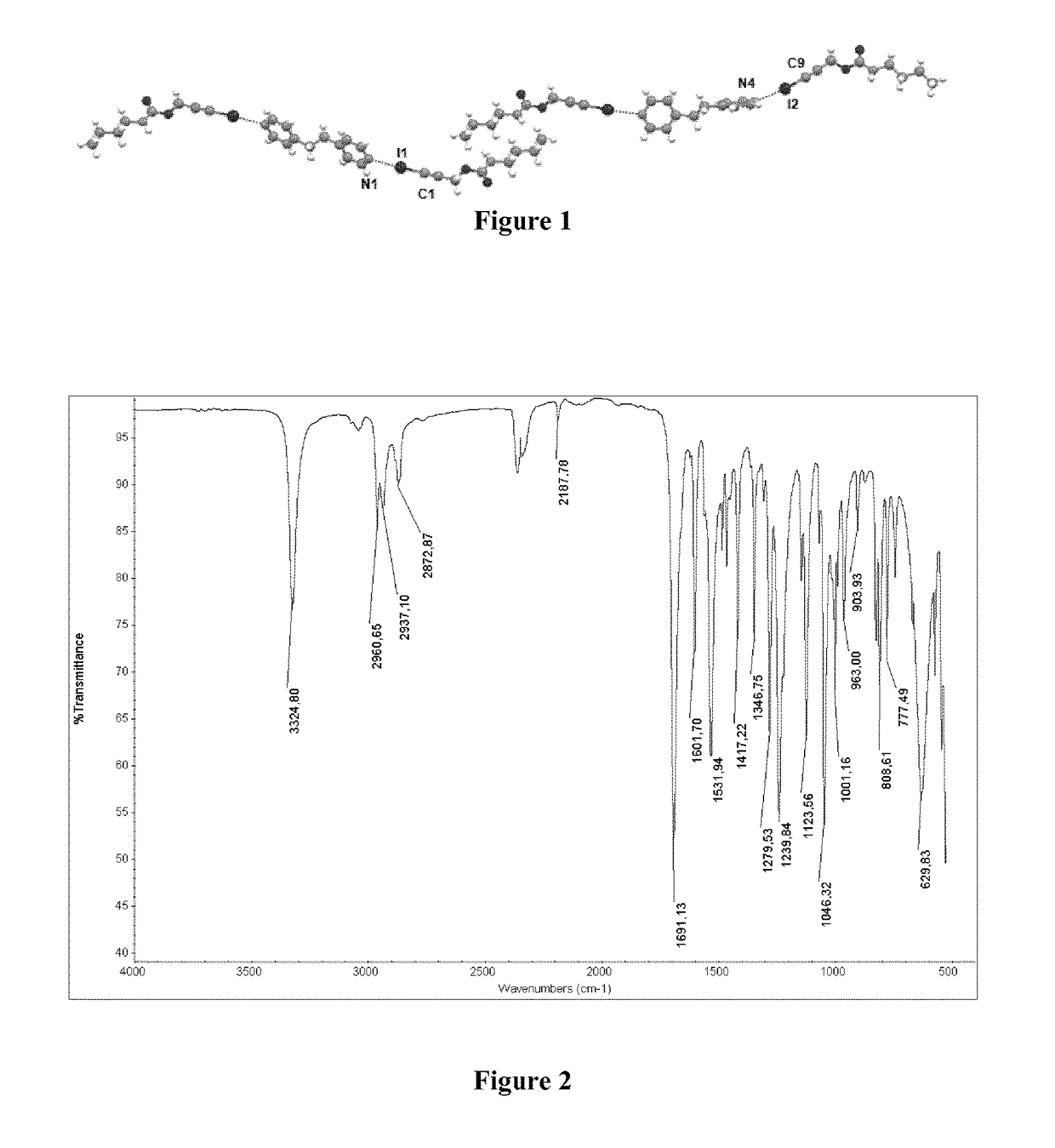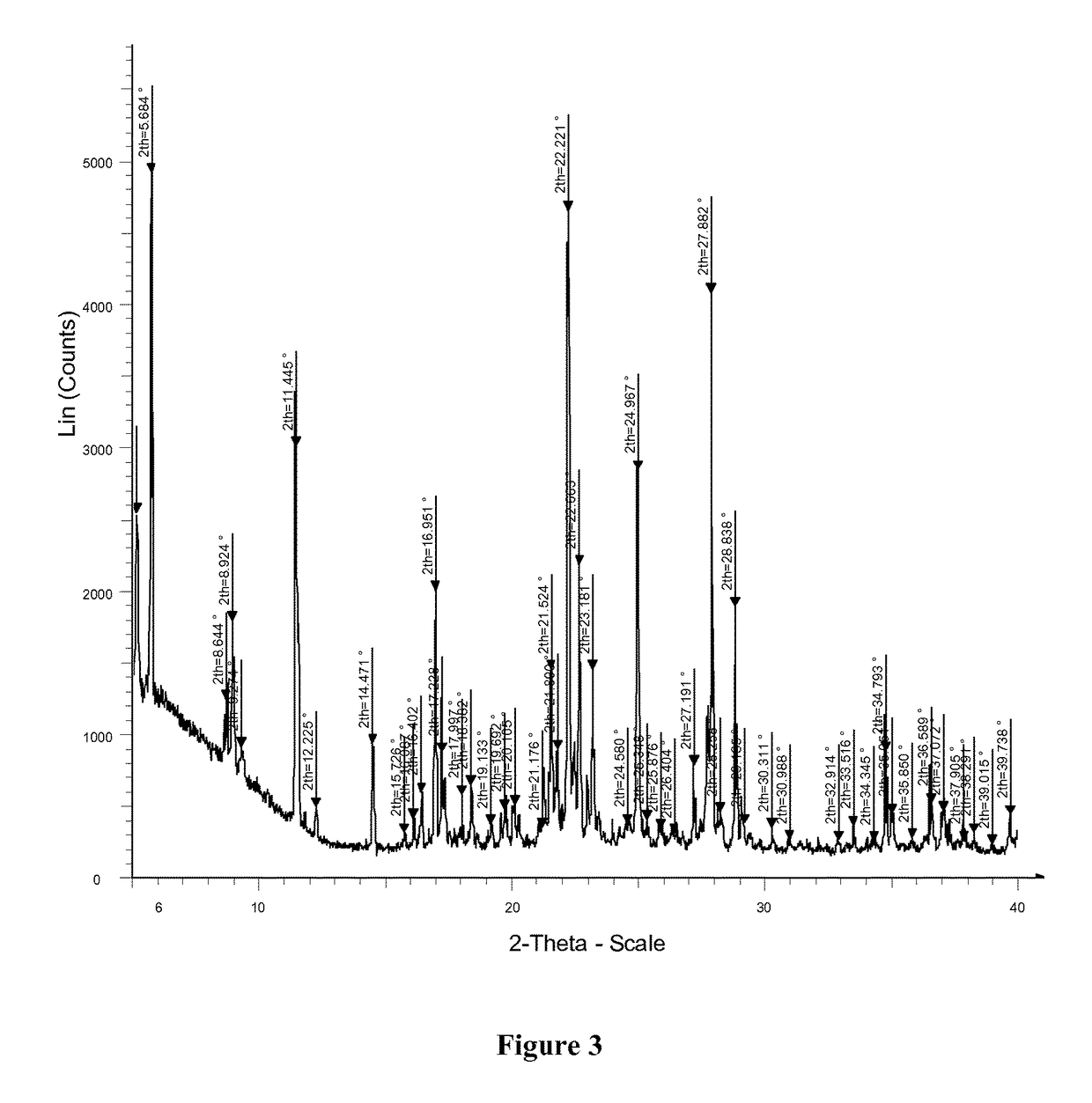Co-crystals of 3-iodopropynyl butylcarbamate
a technology of iodopropynyl butylcarbamate and co-crystals, which is applied in the field of co-crystals of 3iodopropynyl butylcarbamate, can solve the problems of not suggesting the formation of co-crystals involving iodoacetylenyl, difficult use of compound in industrial products and processes, and unsuitable automatic manufacturing devices. achieve the effects of improving
- Summary
- Abstract
- Description
- Claims
- Application Information
AI Technical Summary
Benefits of technology
Problems solved by technology
Method used
Image
Examples
example 1
Co-crystal containing 3-iodopropynyl butylcarbamate and 4-[2-(4-pyridinyl)ethyl]pyridine in a 2:1 Molar Ratio (Co-Crystal 1)
[0105]
[0106]This example demonstrates the ability of IPBC to co-crystallise with a neutral aromatic amine able to act as halogen bond acceptor, such as 4-[2-(4-pyridinyl)ethyl]pyridine.
[0107]Rapid precipitation of the two compounds in a quasi-saturated acetonitrile solution leads to the formation of a solid white powder with a melting point of between 81° C. and 83° C.
[0108]Single-crystal X-ray diffraction demonstrates that in the co-crystal, IPBC and 4-[2-(4-pyridinyl)ethyl]pyridine are present in a molar ratio of 2:1, as shown in FIG. 1. The basic structural pattern in the co-crystal is a trimer unit wherein 4-[2-(4-pyridinyl)ethyl]pyridine acts as bridge between two IPBC molecules via two halogen bonds I- - - N.
[0109]The dimensions and angles of the crystallographic unit cell are [a=30.666(3) b=4.9869(4) c=21.068(2)] and [α=90.00 β=92.115(6) γ=90.00] respect...
example 2
Co-Crystal Containing 3-iodopropynyl butylcarbamate and 4,4′-bipyridine in a 2:1 Molar Ratio (Co-Crystal 2)
[0115]
[0116]This example demonstrates the ability of IPBC to co-crystallise with another neutral aromatic amine able to act as halogen bond acceptor, such as 4,4′-dipyridine.
[0117]In this case the formation of the co-crystal was effected by slow precipitation from an ethanol solution, which leads to the formation of a white powder.
[0118]The basic structural motif in the co-crystal is a trimeric unit, bonded via halogen bonds, consisting of one molecule of 4,4′-bipyridine and two molecules of IPBC, as shown in FIG. 5.
[0119]The co-crystal is a solid crystalline product with a melting point of between 112° C. and 114° C. The dimensions and angles of the crystallographic unit cell are [a=28.683(2) b=4.9270(4) c=21.429(2)] and [α=90.00 β=99.92(2) γ=90.00] respectively.
[0120]The IR spectrum of the co-crystal and its characteristic bands are reported in FIG. 6.
[0121]FIG. 7 shows the X...
example 3
Co-Crystal Containing 3-iodopropynyl butylcarbamate and tetrabutyl ammonium iodide in a 3:1 Molar Ratio (Co-Crystal 3)
[0125]
[0126]This example demonstrates the ability of IPBC to co-crystallise with a halide deriving from an organic salt such as tetrabutylammonium iodide.
[0127]The co-crystal was formed by mechano-chemical synthesis in a ball mill, using a stoichiometric ratio of 1:3 between tetrabutyl ammonium iodide and IPBC.
[0128]The co-crystal obtained contains one molecule of tetrabutyl ammonium iodide and three molecules of IPBC, as shown in the graphical representation in FIG. 9.
[0129]The co-crystal is a solid crystalline product with a melting point between 42° C. and 47.5° C. The dimensions and angles of the crystallographic unit cell are a=10.7688(9) b=20.204(2) c=23.735(2)] and [α=90.00 β=94.778(2) γ=90.00] respectively.
[0130]The IR spectrum of the co-crystal and its characteristic bands are reported in FIG. 10.
[0131]FIG. 11 shows the X-ray powder diffraction (XRPD) of the...
PUM
| Property | Measurement | Unit |
|---|---|---|
| molar ratio | aaaaa | aaaaa |
| molar ratio | aaaaa | aaaaa |
| temperature | aaaaa | aaaaa |
Abstract
Description
Claims
Application Information
 Login to View More
Login to View More - R&D
- Intellectual Property
- Life Sciences
- Materials
- Tech Scout
- Unparalleled Data Quality
- Higher Quality Content
- 60% Fewer Hallucinations
Browse by: Latest US Patents, China's latest patents, Technical Efficacy Thesaurus, Application Domain, Technology Topic, Popular Technical Reports.
© 2025 PatSnap. All rights reserved.Legal|Privacy policy|Modern Slavery Act Transparency Statement|Sitemap|About US| Contact US: help@patsnap.com



